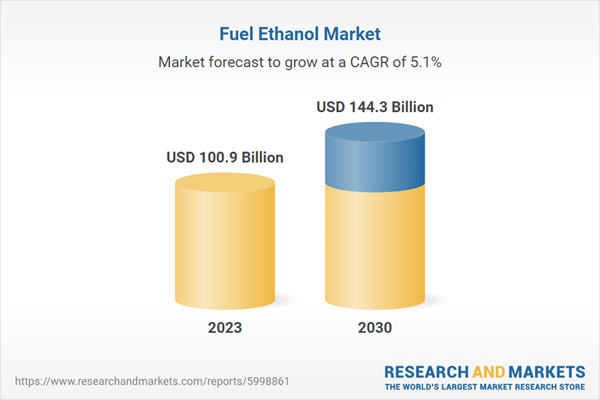Fuel Ethanol Market Growth & Trends
The global fuel ethanol market size is expected to reach USD 144.3 billion by 2030, registering a CAGR of 5.1% from 2024 to 2030. Asia Pacific is estimated to witness a fast paced growth during the forecast period. China, India, and Philippines are the key countries that are considered to positively impact the industry growth in the future.The government of India is currently drawing efforts on enhancing the use of ethyl alcohol as an automotive fuel. The National Policy on Biofuels was implemented in India in 2009, which stated that the oil manufacturing companies were required to distribute petrol blended with a minimum of 5% ethyl alcohol. Furthermore, this policy proposed a target of 20% increase in the blending rate by the end of 2017 in the country.
Growth of the automotive industry in India is another vital factor that is expected to enhance the consumption of the product over the years ahead. Government of India is focusing on making automobile sector as one of the major drivers of the ‘Make in India’ initiative. The manufacturing output of passenger vehicles is likely to reach approximately 9.4 million units by the end of 2026, as stated by the Auto Mission Plan (AMP) 2016-26.
Significant blending mandates in Australia, China, and Philippines are considered to drive the market demand during the forecast period. Australia currently has an E7 ethanol blending mandate implemented in New South Wales. Furthermore, Australia focuses on reaching a 10% biofuels mandate by the end of 2020. In China, nine provinces have proposed a 10% ethanol blends that include Jilin, Henan, Heilongjiang, Liaoning, and Anhui.
Fuel Ethanol Market Report Highlights
- The starch-based dominated the market and accounted for a market share of 75.2% in 2023. These starch-based products can reduce greenhouse emissions and help control air pollution, which has encouraged their use, driving market demand.
- Conventional fuel vehicles dominated the market and accounted for a market share of 83.2% in 2023. This can be attributed to the growing requirements for boosting the fuel economy of these vehicles in several countries, which is expected to increase product consumption in the coming years.
- The North America fuel ethanol market dominated in 2023 and accounted for a market share of 56.4%. It can be attributed to the presence of the well-established automotive industry and its strict regulations over particulate emissions.
- Asia Pacific fuel ethanol market is expected to grow at the fastest CAGR over the forecast period. It can be attributed to the rising number of investments and the various government initiatives and developments for sustainable development.
Why should you buy this report?
- Comprehensive Market Analysis: Gain detailed insights into the global market across major regions and segments.
- Competitive Landscape: Explore the market presence of key players worldwide.
- Future Trends: Discover the pivotal trends and drivers shaping the future of the global market.
- Actionable Recommendations: Utilize insights to uncover new revenue streams and guide strategic business decisions.
This report addresses:
- Market intelligence to enable effective decision-making
- Market estimates and forecasts from 2018 to 2030
- Growth opportunities and trend analyses
- Segment and regional revenue forecasts for market assessment
- Competition strategy and market share analysis
- Product innovation listing for you to stay ahead of the curve
- COVID-19's impact and how to sustain in these fast-evolving markets
This product will be delivered within 1-3 business days.
Table of Contents
Chapter 1. Methodology and Scope
Chapter 2. Executive Summary
Chapter 3. Fuel Ethanol Market Variables, Trends, & Scope
Chapter 4. Fuel Ethanol Market: Product Estimates & Trend Analysis
Chapter 5. Fuel Ethanol Market: Technology Estimates & Trend Analysis
Chapter 6. Fuel Ethanol Market: Application Estimates & Trend Analysis
Chapter 7. Fuel Ethanol Market: Regional Estimates & Trend Analysis
Chapter 8. Competitive Landscape
Companies Mentioned
- Braskem S.A.
- BP Plc
- Cargill Incorporated
- INEOS Group Limited
- HPCL Biofuels Limited
- LyondellBasell Industries Holdings BV
- Mitsubishi Chemical Corporation
- SABIC
- Sasol Limited
- Solvay SA
Methodology

LOADING...
Table Information
| Report Attribute | Details |
|---|---|
| No. of Pages | 80 |
| Published | August 2024 |
| Forecast Period | 2023 - 2030 |
| Estimated Market Value ( USD | $ 100.9 Billion |
| Forecasted Market Value ( USD | $ 144.3 Billion |
| Compound Annual Growth Rate | 5.1% |
| Regions Covered | Global |
| No. of Companies Mentioned | 10 |









